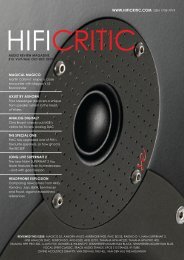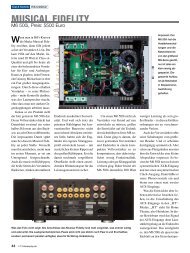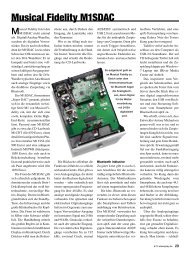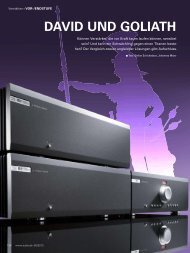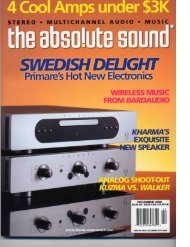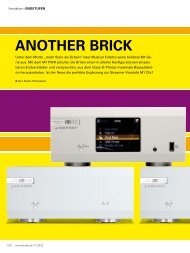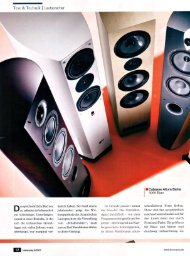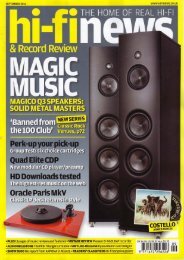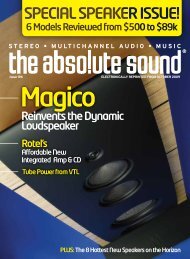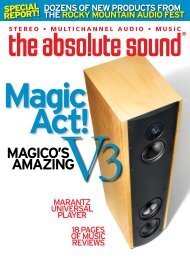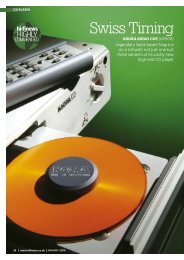MG 3.6: Magnepan's Newest Exotic Blend of Music and Magic - BM.rs
MG 3.6: Magnepan's Newest Exotic Blend of Music and Magic - BM.rs
MG 3.6: Magnepan's Newest Exotic Blend of Music and Magic - BM.rs
You also want an ePaper? Increase the reach of your titles
YUMPU automatically turns print PDFs into web optimized ePapers that Google loves.
FUSING – The mid <strong>and</strong> treble sections <strong>of</strong> the <strong>MG</strong><strong>3.6</strong>/R are protected with Type SAG<br />
normal blow fuses (4 amp for midrange; 2-1/2 amp for tweeter). The bass section does<br />
not require fusing protection. The fuse values should never be increased or bypassed.<br />
Do not use slow-blow fuses. Fuses remain in effect when bi-amplifying. This is done for<br />
your protection since it prevents overdriving from an amplifier, or the distortion that<br />
results from an overdriven amplifier (clipping).<br />
In case the <strong>MG</strong><strong>3.6</strong>'s do not sound "quite right," especially after high volume levels,<br />
please check the midrange fuse. When it is blown some owne<strong>rs</strong> do not realize it, since<br />
a blown midrange fuse is not as apparent as a blown tweeter fuse. Some amplifie<strong>rs</strong> will<br />
distort or go into thermal overload when driving <strong>MG</strong><strong>3.6</strong>'s with a blown midrange fuse.<br />
BURNED OUT MID OR TREBLE SECTIONS ARE NOT COVERED<br />
UNDER THE WARRANTY.<br />
8. SPEAKER PLACEMENT<br />
Proper speaker placement <strong>and</strong> room acoustics can have more effect on a music<br />
system than upgrading one <strong>of</strong> the components in the system. Unfortunately, there is no<br />
definitive guideline which will cover all possible listening rooms. Considerable<br />
experimentation is required for locating the optimum position. The following are a few<br />
general guidelines:<br />
TWEETER PLACEMENT<br />
The <strong>MG</strong><strong>3.6</strong> tweete<strong>rs</strong> are mirror-imaged. For proper phasing between the bass,<br />
midrange, <strong>and</strong> tweeter, the bass driver should be closer to the listener than the<br />
tweeter (ahead in time). If the tweete<strong>rs</strong> are placed on the outside, the angle <strong>of</strong><br />
the speaker in relation to the listener should be as shown in Figure 3. If the<br />
tweete<strong>rs</strong> are placed on the inside, the speaker angle should be as shown in<br />
Figure 4.<br />
BASS RESPONSE<br />
If you do not have access to a spectrum analyzer, play a record with a repetitive<br />
bass line (preferably an acoustical bass instrument). Try the speake<strong>rs</strong> in several<br />
parts <strong>of</strong> the room. Start experimenting with the speake<strong>rs</strong> about 3 feet from the<br />
back wall. Try moving the speake<strong>rs</strong> forward or backward by increments <strong>of</strong> 6 to<br />
12 inches at a time. One part <strong>of</strong> the room should be noticeably better than the<br />
rest, as should one distance from the rear wall as shown in Figure 5.



